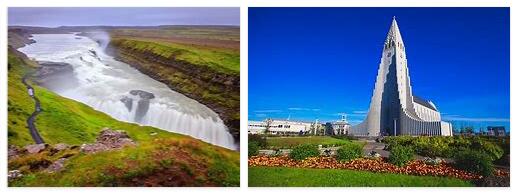Iceland Landmarks
Thingvellir National Park
Breathtaking nature and a lot of history
The heart of the Icelandic nation has been beating here for over a millennium
Thingvellir National Park, founded in 1928 and now 237 km² in size, is located on the north bank of the 80 km² lake Þingvallavatn in the area of the two municipalities Bláskógabyggð and Grímsnes og Grafningur in the capital area (“Höfuðborgarsvæðið”) around Reykjavík in southwest Iceland.
Translated into German, the Icelandic name is roughly “level of the people’s assembly”, which already points to the historical significance of the place. In fact, not far from the Almannagjá Gorge, after the conquest of the island by mainly Norwegian Vikings in the middle of the 10th century, the chiefs met and gathered three times a year to give advice. The intersection of the strategically most important equestrian trails at the time was easily accessible from all regions populated at the time. As “Alþing” this regular and worldwide one of the oldest parliamentary meetings existed until 1798 and the dissolution by the Danish occupiers.
A short dive in the cold clear water between America and Eurasia
The Thingvellir area owes its status as a UNESCO World Heritage Site since 2004 to the two historically traditional and nationally significant dates of the acceptance of Christianity in Iceland in 1000 and the proclamation of the Republic in June 1944. In the summer of 1994, numerous ceremonies for the 50th anniversary took place here the founding of the state. Weathered and overgrown walls on the edge of the former meeting place are architectural witnesses of the medieval gatherings. A trip to the national park is also worthwhile for holidaymakers interested in geology and geological history, because it is located in the western rift zone and is surrounded by the four active volcanic systems Hengill and Hrómundartindur as well as Hrafnabjörg and Prestahnúkur.
Marvel at big fish and golden destinations not far from Reykjavík
The extensive Þingvallavatn lake is also known to be extremely rich in fish, the dominant species of trout and char in the water attract numerous anglers. A visit to the national park and its scenic surroundings can be easily combined with a round trip on the approximately 300 kilometer long holiday road “Gullni hringurinn” (Golden Tour) to many attractions in the south and southwest of Iceland.
Vatnajokull National Park
Iceland is famous for its breathtaking landscapes. The Scandinavian country has long been more than an insider tip, especially for nature lovers and adventure vacationers. A real must for visitors to Iceland is Vatnajökull National Park. After all, some of Iceland’s greatest natural wonders can be admired here in one of the largest national parks in Europe. In total, the park covers an area of almost 14,000 square kilometers. So you should plan a lot of time when visiting the Vatnajökull National Park, which was founded in June 2008 and is characterized by an impressive variety of landscapes.
Fascinating sights: waterfalls, volcanoes, glaciers
In the north is Dettifoss, one of the largest and most spectacular waterfalls in Europe. Another popular tourist magnet within the Vatnajökull National Park is the Askja central volcano, which is the center of the approximately 200-kilometer-long volcanic system of the same name. In the south, the Vatnajökull glacier, which gave the national park its name, casts its spell over numerous locals and tourists from all over the world every day. Near the glacier, which covers more than 8,000 square kilometers, is the Morsárfoss, the highest waterfall in the country, which is also a popular attraction. If you want to experience an impressive flora and fauna, you should look around in the east of the national park.
Geosea geothermal bath
With a breathtaking view of the ocean, the Geosea geothermal bath in Húsavik on the north coast of Iceland offers a very special and unforgettable bathing experience. With a little luck, visitors to this seaside resort even have the fantastic opportunity to watch whales in the sea. The geothermal bath is about 90 km away from the city of Akureyri, the second largest city in Iceland. According to the Icelandic Tourist Office, adults pay 4300 kroner to enter, which is the equivalent of around € 32. For children under 16 years of age, the entrance fee is 1600 crowns. The entire geothermal system is heated by natural geothermal energy. Visitors have the choice between 3 pools, modern and stylish bathing in the warm thermal water is a treat for body, mind and soul.
Relaxation with a fantastic view of the Skyrim mountain ranges
So if you are traveling in the north-east of Iceland, Geosea should not be missed. The Geosea Bath is uniquely located on a cliff and the pleasantly warm water temperature is around 38 ° C. With a view of the bay of Skj lfanda and with mountains and pleasant music in the background, the relaxation experience for adults and children is absolutely fantastic. The well-equipped changing rooms of the thermal bath are equipped with spacious lockers as well as shampoo, conditioner and shower gel. The associated building in a fantastic design is well camouflaged from the outside in the grass and was built directly into the slope. With a direct view of wildlife, sea and mountains, a visit to the Geosea geothermal bath offers a unique Icelandic experience.
Husavik offers more activities and sights
As everywhere in Iceland, there is a lot to discover and experience besides swimming. Whale watching is a must have, but also the Diamant Circle, a 250 km tour the city has planned as a sight next to Ásbyrgi Canyon, Lake Mývatn and the Dettifoss waterfall. In the city’s restaurants you have numerous opportunities to enjoy regional cuisine.





